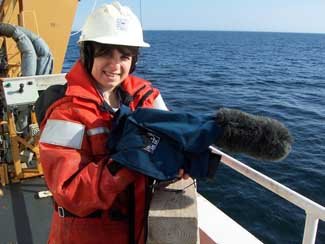Bering Sea: Back to the Future
If she had a time machine, Beth Caissie from the University of Massachusetts, Amherst, would probably transport herself back about 20,000 years ago to investigate ice in the Bering Sea at that time. Instead, she relies on the next best thing: sediment from the seafloor that holds an archive of life dating back 20,000 years. Understanding how the ice cover has changed over time will give researchers an inkling of what to expect in the future.
“I’m looking at diatoms, which are yellow-brown algae that like sea ice,” said Caissie. “ I’m comparing the species that live in the sea ice now and look down in time to see when those species were prevalent in the sediment.” Looking “down in time” means investigating the deeper layers of sediment. The deeper the layer, the older the mud. The older the mud, the older the diatoms. Unlike rock-based dirt on land, the sediment on the seafloor consists of diatoms and other tiny plants made of silica, the same chemical in glass.
diatoms and other tiny plants made of silica, the same chemical in glass.
Caissie and other scientists aboard the Healy use a device called a Haps Corer to collect cylinder-shaped tubes of mud from the seafloor. They carefully prepare the tubes for travel back to the lab in Massachusetts for later testing. Each sample is painstakingly recorded, so scientists know where it came from and how long the sea ice covered that spot.
Caissie will prepare microscope slides of the mud so she can see the different species of diatoms that lived 20,000 years ago. “So I will look back in time to 20,000 years ago,” she said. “If I see a species that today lives in an area where there’s eight months of sea ice, it’s probably safe to say there was eight months of sea ice in that same spot 20,000 years ago.” Only time, and research, will tell how the sea ice will change in the future.
“I’m looking at diatoms, which are yellow-brown algae that like sea ice,” said Caissie. “ I’m comparing the species that live in the sea ice now and look down in time to see when those species were prevalent in the sediment.” Looking “down in time” means investigating the deeper layers of sediment. The deeper the layer, the older the mud. The older the mud, the older the diatoms. Unlike rock-based dirt on land, the sediment on the seafloor consists of
 diatoms and other tiny plants made of silica, the same chemical in glass.
diatoms and other tiny plants made of silica, the same chemical in glass.Caissie and other scientists aboard the Healy use a device called a Haps Corer to collect cylinder-shaped tubes of mud from the seafloor. They carefully prepare the tubes for travel back to the lab in Massachusetts for later testing. Each sample is painstakingly recorded, so scientists know where it came from and how long the sea ice covered that spot.
Caissie will prepare microscope slides of the mud so she can see the different species of diatoms that lived 20,000 years ago. “So I will look back in time to 20,000 years ago,” she said. “If I see a species that today lives in an area where there’s eight months of sea ice, it’s probably safe to say there was eight months of sea ice in that same spot 20,000 years ago.” Only time, and research, will tell how the sea ice will change in the future.


<< Home